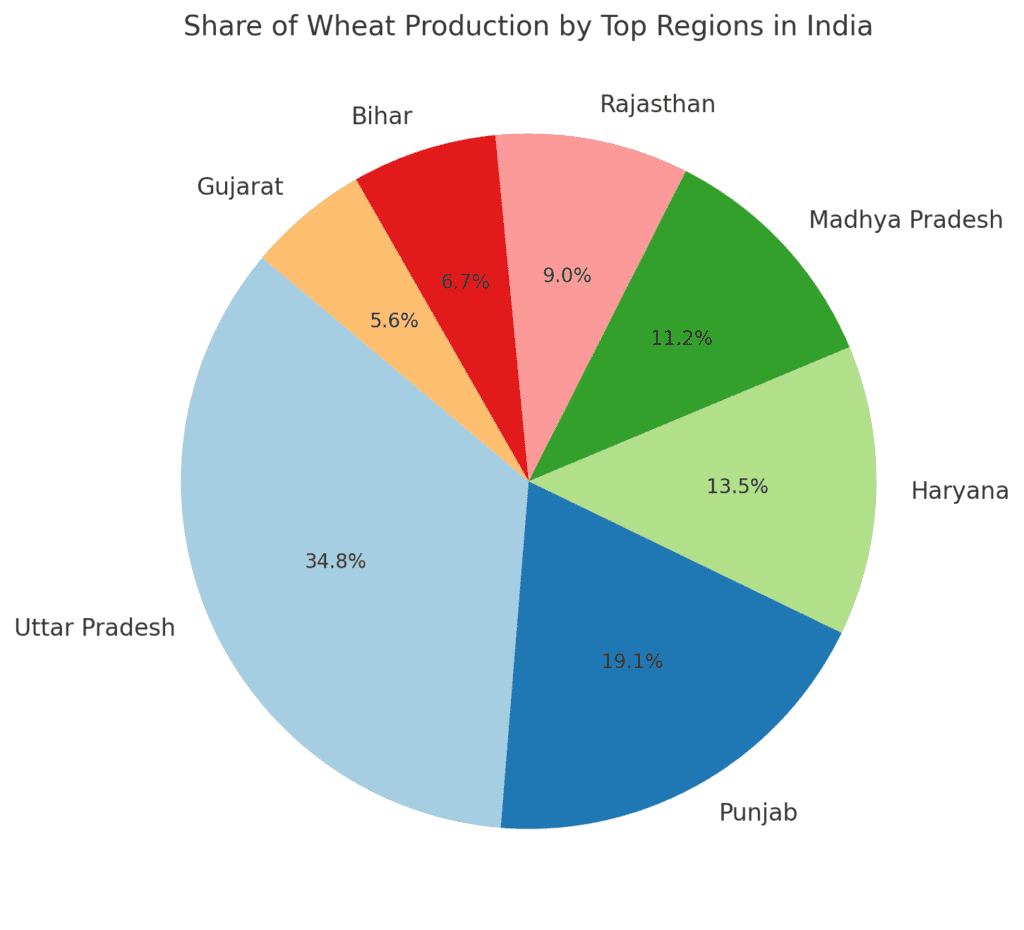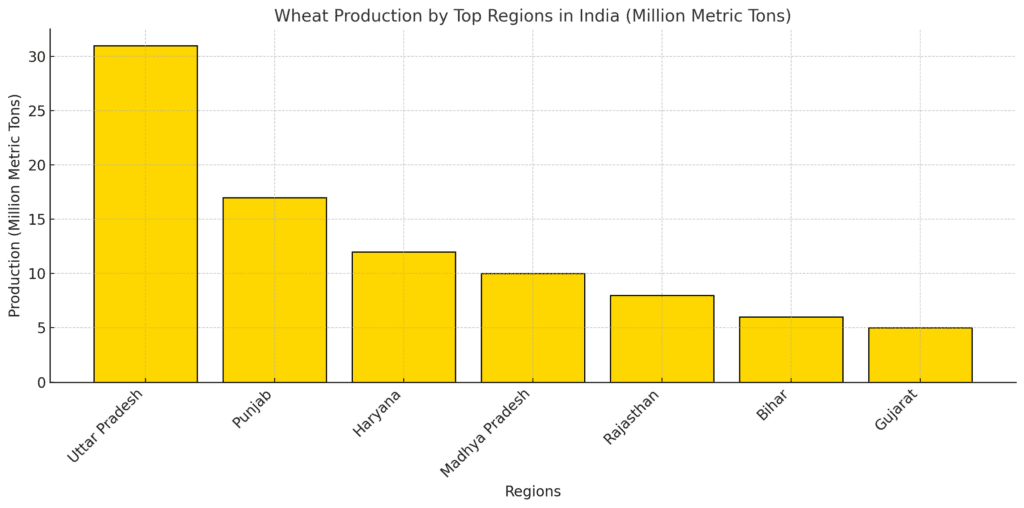India is the second-largest wheat producer in the world, contributing significantly to global food security. Wheat is a staple crop for the country, forming an essential part of the Indian diet in the form of chapati, naan, and other traditional dishes. This article explores the largest wheat-producing regions in India, their contributions to agriculture, and the innovations driving growth in the sector.

1. Uttar Pradesh: India’s Wheat Powerhouse
Uttar Pradesh (UP) is the largest wheat-producing state in India, thanks to its fertile alluvial plains and extensive irrigation networks.
- Annual Production: Approximately 31 million metric tons.
- Key Areas: Kanpur, Allahabad, and Meerut.
- Agricultural Features: Access to Ganga and Yamuna river systems, providing abundant water supply.
- Innovations: Use of high-yield wheat varieties and advanced irrigation methods like drip irrigation.
- Significance: Accounts for over 30% of India’s total wheat production, ensuring food security for the nation.
2. Punjab: The Grain Bowl of India
Punjab is renowned for its highly productive agricultural sector, with wheat as one of its primary crops.
- Annual Production: Around 17 million metric tons.
- Key Areas: Ludhiana, Amritsar, and Patiala.
- Agricultural Features: Fertile soils, canal irrigation, and mechanized farming.
- Innovations: Extensive use of modern machinery, hybrid seeds, and sustainable practices.
- Significance: A major contributor to India’s food grain reserves under the Green Revolution.
3. Haryana: A Leader in Agricultural Efficiency
Haryana plays a crucial role in India’s wheat production with its advanced farming practices.
- Annual Production: Approximately 12 million metric tons.
- Key Areas: Karnal, Kurukshetra, and Ambala.
- Agricultural Features: High groundwater availability and extensive irrigation networks.
- Innovations: Adoption of precision farming techniques and pest-resistant crop varieties.
- Significance: Haryana’s wheat contributes significantly to India’s public distribution system (PDS).
4. Madhya Pradesh: An Emerging Wheat Producer
Madhya Pradesh has rapidly increased its wheat production, becoming a key player in Indian agriculture.
- Annual Production: Around 10 million metric tons.
- Key Areas: Indore, Bhopal, and Gwalior.
- Agricultural Features: Expanding irrigation facilities and fertile black soil.
- Innovations: Promotion of organic farming and water conservation techniques.
- Significance: The state’s Sharbati wheat is known for its superior quality and high demand.
5. Rajasthan: A Contributor in Arid Regions
Despite its arid climate, Rajasthan produces a significant amount of wheat through efficient water management.
- Annual Production: Approximately 8 million metric tons.
- Key Areas: Jaipur, Kota, and Ajmer.
- Agricultural Features: Use of canal systems like the Indira Gandhi Canal for irrigation.
- Innovations: Focus on drought-resistant wheat varieties and micro-irrigation techniques.
- Significance: Supplies wheat to northern and western India.
6. Bihar: A Traditional Wheat-Growing State
Bihar is a traditional wheat-growing region, benefiting from its fertile Gangetic plains.
- Annual Production: Around 6 million metric tons.
- Key Areas: Patna, Gaya, and Bhagalpur.
- Agricultural Features: Alluvial soils and abundant water resources from rivers.
- Innovations: Introduction of modern farming equipment and high-yield varieties.
- Significance: Supports food grain requirements in eastern India.
7. Gujarat: A Unique Wheat Producer
Gujarat’s wheat production is concentrated in regions with canal irrigation and fertile soils.
- Annual Production: Approximately 5 million metric tons.
- Key Areas: Ahmedabad, Rajkot, and Surat.
- Agricultural Features: Use of Narmada canal water for irrigation.
- Innovations: Encouragement of contract farming and integrated pest management.
- Significance: Contributes to wheat supply for domestic and export markets.

Innovations in India’s Wheat Production
India’s wheat-producing regions are embracing various innovations to enhance productivity:
- High-Yield Varieties: Introduction of hybrid and pest-resistant wheat strains.
- Precision Agriculture: Use of GPS and drones for monitoring crop health.
- Sustainable Practices: Promotion of organic farming and water conservation.
- Mechanization: Adoption of tractors, harvesters, and automated irrigation systems.
Challenges Facing Wheat Production in India
Despite advancements, India’s wheat industry faces several challenges:
- Climate Change: Rising temperatures and erratic rainfall threaten yields.
- Water Scarcity: Over-dependence on irrigation depletes groundwater resources.
- Soil Degradation: Overuse of fertilizers reduces soil fertility.
Conclusion
India’s largest wheat-producing regions, including Uttar Pradesh, Punjab, and Haryana, are critical to the nation’s food security and agricultural economy. By adopting modern farming techniques and sustainable practices, these regions are meeting domestic demand and contributing to global wheat markets. As challenges like climate change persist, continued innovation will be key to sustaining growth in this vital sector.



